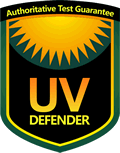How to Cut Artificial Grass: A Step-by-Step Guide
- 2024-08-23
Cutting artificial grass is a crucial step in the installation process, whether you’re laying it in your backyard, around a landscape feature, or creating a putting green. The precision of your cuts will determine how well your artificial grass fits the area, and ultimately, how natural it looks.
In this guide, we’ll walk you through the tools you’ll need, basic cutting methods, and tips to ensure your artificial grass installation is smooth and seamless.
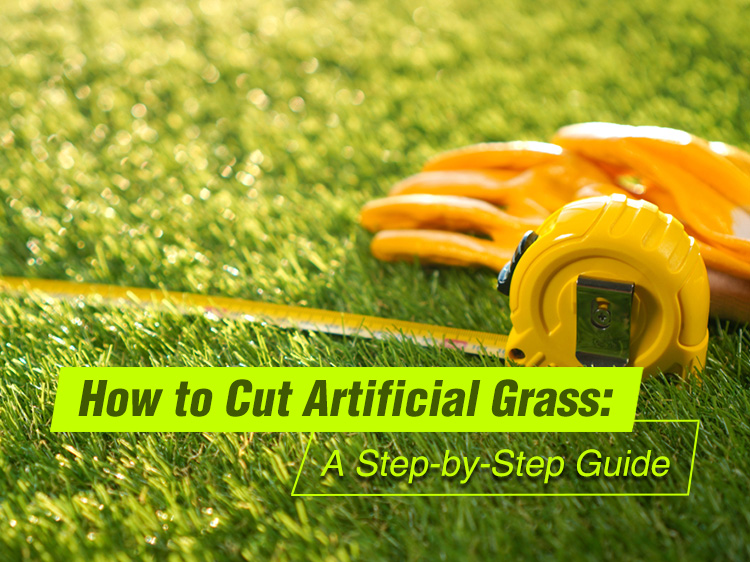
Table of Contents
TogglePreparation for cutting artificial grass
Preparing the grass
Before making any cuts, unroll the artificial grass and let it sit for a few hours or overnight. This allows the grass to relax and flatten out, making it easier to work with and achieving more accurate cuts.
Preparing the sub-base
Proper groundwork is crucial for a successful installation. For detailed steps on preparing the sub-base, refer to our dedicated installation guide. Make sure the ground is well-prepared to ensure a smooth and effective setup.
What are the best tools to cut artificial grass?
To cut artificial grass accurately and efficiently, having the right tools is essential. Here’s a list of what you’ll need:
Utility knife: A sharp utility knife is your go-to tool for clean, precise cuts. It’s particularly useful for trimming around edges and obstacles. Ensure you have extra blades on hand, as they can dull quickly when cutting through the tough backing of the grass.
Heavy-duty scissors: While a knife is best for most cuts, heavy-duty scissors can be useful for smaller, more detailed work, especially around tight corners or intricate shapes.
Measuring tape: Accurate measurements are key to cutting your artificial grass correctly the first time.
Chalk or marker: Useful for marking your cut lines before you start cutting.
Straight edge or ruler: Use this to mark straight and even cutting lines.
Cut-resistant gloves: Safety first! Wearing gloves will protect your hands from sharp blades and reduce the risk of injury.
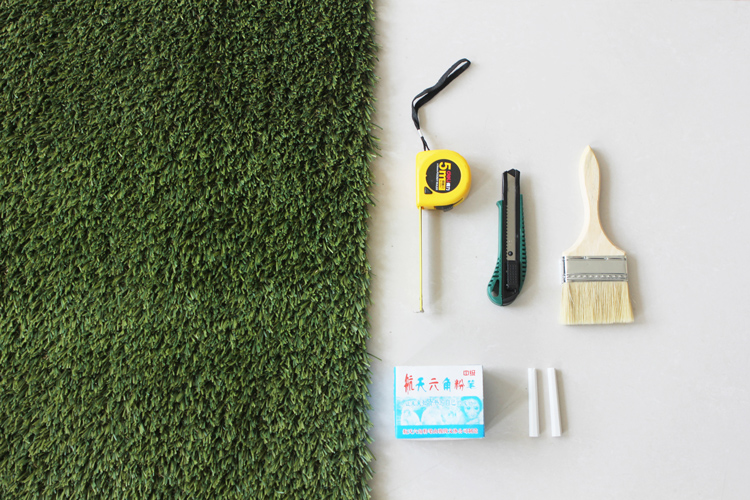
Basic methods for cutting artificial grass
Cutting artificial turf might seem straightforward, but different situations require different techniques. Below are some of the most common scenarios you’ll encounter and how to handle them.
How to cut artificial grass straight
Cutting fake grass in a straight line is essential for most installations, providing a clean and polished appearance.
Cutting around edges
When installing artificial grass along the perimeter of a space, such as against a fence, pathway, or patio, straight cuts are essential.
Position the grass: Unroll the artificial grass and lay it flat over the area, ensuring it extends slightly beyond the edge you plan to cut.
Mark the cut lines: Use a straight edge and chalk or marker to draw a cutting line on the grass backing.
Make the cut: With a sharp utility knife, carefully cut along the marked line. As you cut, pull the excess piece of turf up and back to prevent bunching and ensure a smooth edge.
Final fit: Check the fit of the grass against the edge, maintaining a gap of no more than 1/4 inch for a clean finish.
Joining multiple rolls of artificial grass
When covering a large area, you’ll likely need to join multiple rolls of artificial grass.
Align the rolls: Lay the rolls side by side, making sure the grain (the direction of the grass blades) is running the same way on both rolls.
Trim the edges: Remove the manufacturing edge strip (if present) or trim another stitch so that there is as little backing as possible next to the stitch and butt the two edges together.
Secure the seam: Once the edges are perfectly aligned, apply adhesive or seam tape beneath the joint.
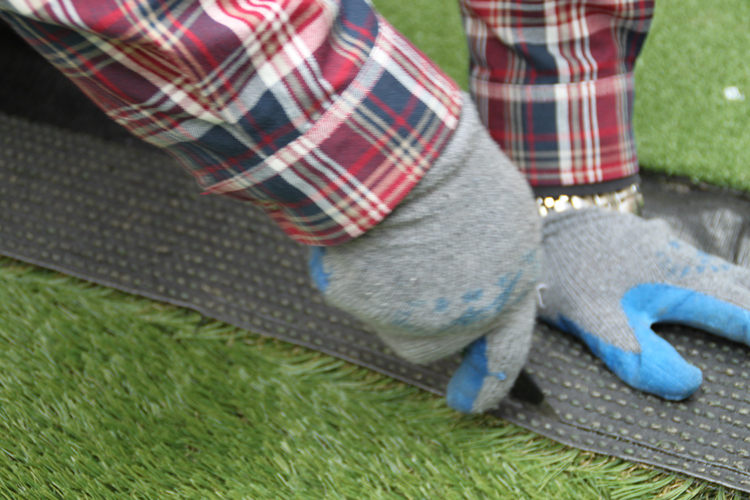
How to cut artificial grass around curves
Cutting artificial grass to fit around curves requires a bit more finesse and attention to detail. This is common when working around trees, curved pathways, or garden beds.
Cutting around a tree
When installing artificial grass around a tree, achieving a smooth fit without wrinkles or bubbles is crucial.
Make initial cuts: Start by laying the artificial grass over the area around the tree. Make small, general cuts near the tree’s base to help the grass lay flat. Avoid removing large sections at once, work in smaller increments instead.
Trim gradually around the trunk: Place one edge of the grass over the side of the tree and carefully work around the trunk. Make perpendicular cuts from the tree’s base towards the lawn’s edge, creating smaller sections as you move around the trunk.
Refine the shape: For a circular fit around the tree, sketch the desired outline on the turf backing. Use heavy-duty scissors to trim from the inside of the tree toward the sketch, closely following the curve.
Cutting a golf hole
Install the turf: Lay the putting green turfover the intended area. Press down with your hand to locate the pre-installed golf cup.
Mark the hole: Use chalk to draw the complete outline of the golf hole on the grass.
Cut an “X” in the marked circle: With a utility knife, cut an “X” in the middle of the marked circle to begin removing the turf.
Remove turf: Cut away the turf piece by piece, from the center of the “X” outward, until the golf cup is visible.
Cutting along curved pathways or flower beds
Mark the curve: With the grass laid in place, mark the curve on the underside using chalk or a marker.
Cut along the marked line: With a utility knife, carefully cut along the marked line. Follow the curve closely, taking your time to ensure the cut is smooth and continuous.
Refine and secure: Trim any rough edges for a smooth finish. For curves, leave a small gap of about 1/8 inch between the grass edge and the feature.Secure with U-shaped nails along the curve.
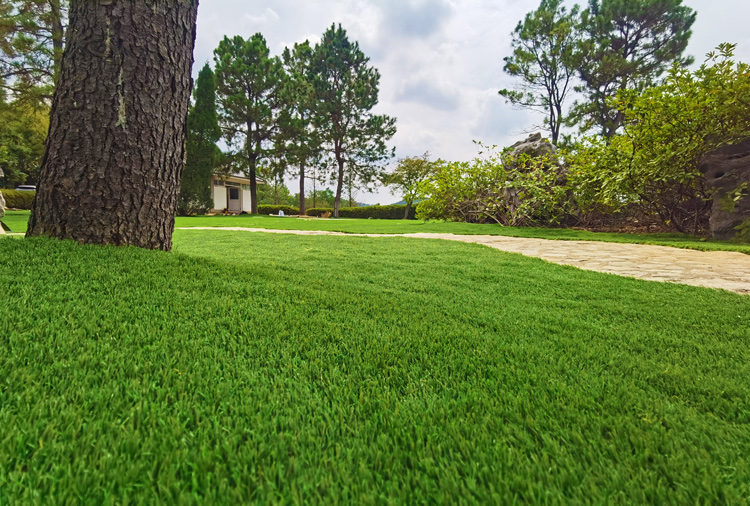
How to cut artificial grass for unique shapes
Cutting grass to fit between pavers
Measure the gaps: Measure the width and length of the gaps between the pavers or stones where you plan to install the grass strips.
Cut the grass into strips: Using a utility knife cut the grass into strips that match the measurements of the gaps. The strips should be slightly wider, about 1/4 inch, than the gaps to allow for a tight fit.
Fit and secure the strips: Place the grass strips into the gaps between the pavers, trimming any excess for a precise fit. Secure the strips to the base layer using U-shaped nails, spacing them every 2 inches along the edges and every 2 feet throughout the strips.
Cutting grass for irregular shapes
Artificial turf can be cut into virtually any shape. Be careful not to cut through the stitches, as this can cause fibres to loosen. If you do, don’t worry—some fibers might fall out, but it won’t usually affect the overall look.
Our innovative RCX Series, with no latex, no PU, and no coating, is designed to make DIY cutting easier and more precise.
Mark the outline: Use chalk or a marker to trace the desired shape onto the grass backing. For more complex designs, a cardboard template can help guide your cuts.
Cut in sections: Make cuts in smaller sections following the marked outline. This approach provides greater control and accuracy, especially around intricate areas.
Test and adjust: Regularly check the fit of the grass in the space. Make any necessary adjustments by trimming excess material to achieve a perfect match.
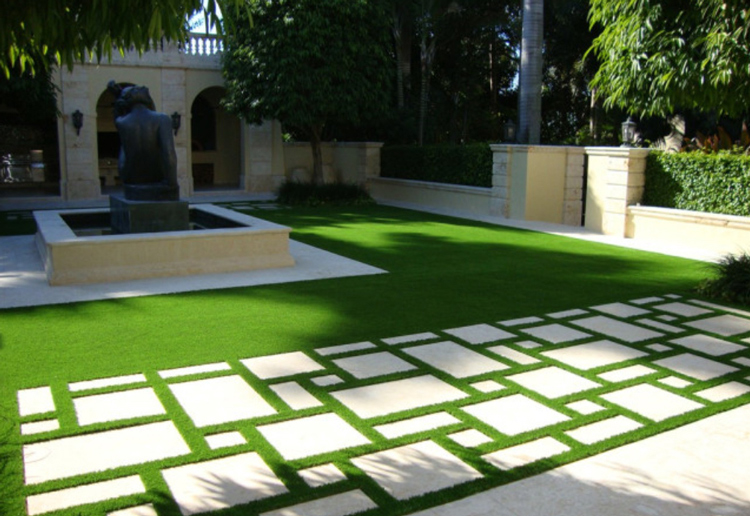
Final tips for accurate cutting
Take your time: Don’t rush the cutting process. Going slowly helps avoid mistakes that are hard to fix.
Use sharp blades: Always use a sharp blade when cutting artificial grass. A dull blade can cause jagged cuts, frayed edges, and uneven lines.
Measure twice, cut once: Double-check your measurements before cutting. It’s easier to trim a bit more than to correct an over-cut.
Make test cuts: If you’re unsure about a cut, make a small test cut on a scrap piece of grass first. This will give you a feel for the process and reduce the chance of errors.
Cut from the back: Whenever possible, cut from the back of the grass. This keeps the front looking clean and prevents accidental fiber loss.
Conclusion
Cutting artificial grass is a crucial step in ensuring a successful installation. With the right tools, techniques, and a bit of patience, you can achieve clean, precise cuts that enhance the appearance and longevity of your artificial lawn.
For our wholesale and retail partners, this guide is a handy tool to help you serve your customers effectively. We’re here to help you every step of the way and strengthen our partnership through comprehensive market support.
If you’re interested in learning more about our products or have any questions, please reach out to us at 86 25 6981 1666 or email us at [email protected].





 Tel:
Tel:  E-mail:
E-mail: 